
Piñatas are more than something to smash. This exhibit shows why
LOS ANGELES — My earliest piñata memory is jogged by an old photograph taken in 1980.
Twenty brown kids in bathing suits are packed into my aunt's backyard in Rosemead, California, eagerly waiting to hit what looks like a half-human, half-dog piñata. A red and green engraved wooden piñata bat is in my brother's hand and a rope suspending the piñata is in my aunt's. Piñatas back in the day weren't custom made to look like your kid's favorite Disney character.
My grandpa was tasked with picking one up at El Mercadito in East Los Angeles. You may have found one on Olvera Street before the first rumblings of the Piñata District were felt on Olympic and Central. Today, these ephemeral papier mâché pieces are sold everywhere from Target to the 99 Cents Only store.
But what was once relegated to birthday parties and celebrations is an art form specialized by Yesenia Prieto, Roberto Benavidez, Amorette Crespo, Diana Benavidez and Justin Favela, whose rare pieces are on display through Dec. 4 in "Piñatas: The High Art of Celebration" at the Craft in America center. They are just some of the artists featured in an exhibit that pays homage to traditional piñata artisans and those riffing on a highly underappreciated craft.
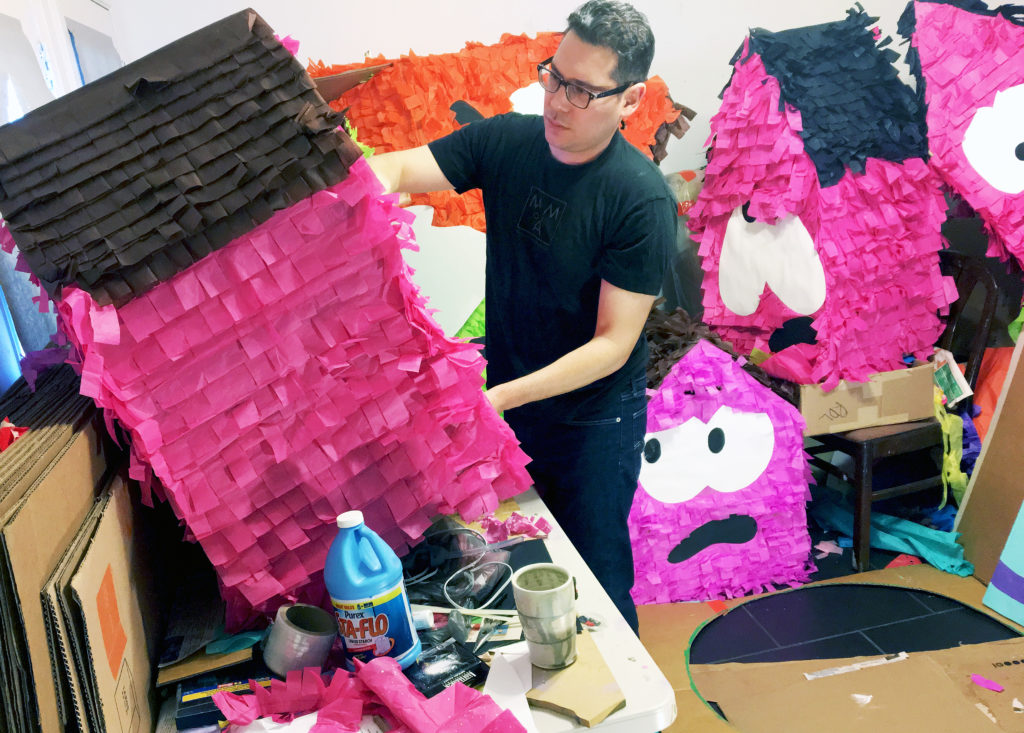
It's hard to believe there has never been a piñata exhibit in L.A. Emily Zaiden, Craft in America's director and lead curator, spent four years researching a craft with little written on its history and only found one exhibit held at the National Hispanic Cultural Center (NHCC) in Albuquerque, New Mexico. She was inspired by The Getty's 2017 "Pacific Standard Time: LA/LA" exhibit, which took an elaborate dive into Latin American and Latino art in Los Angeles with a series of exhibits, public programs, workshops, symposia and performances held at arts institutions across Southern California.
"I grew up in L.A. and piñatas are very much a part of our lives," Zaiden said. "These are undocumented objects that someone takes a lot of time to make and we tear them apart."
Craft in America is a nonprofit art space opened in 2009, in part, as a way for viewers of its PBS show to see artwork from the episode in person. Far from any physical piñata shop, the gallery brings together works from an eclectic group of artists, including Isaías Rodriguez, also known as Little Piñata Maker, who in 2016 collaborated with artist Sita Kuratomi Bhaumik to create a scale model of Donald Trump's proposed border wall proportionate to the height of the then-presidential candidate. "Estamos Contra El Muro/We Are Against the Wall" featured more than 300 piñata cinder blocks produced by Oakland party supply store Piñatas Las Morenitas Martinez with initial prototypes by Ivan Padilla Mónico of Michoacan, Mexico. Originally displayed at Southern Exposure in San Francisco, the piñata art installation was tagged and painted by muralist Cece Carpio. When destroyed, it left scraps of tissue paper-laden cardboard that was framed and featured five years later for this exhibit.
Get a glimpse of "Estamos contra el muro| We Are Against the Wall," an exhibit by Sita Kuratomi Bhaumik, in collaboration with Piñatas Las Morenitas Martínez, Little Piñata Maker, Cece Carpio (Trust Your Struggle), Iván Padilla Mónico, La Pelanga, People's Kitchen Collective and Norma Listman, exhibited at Southern Exposure in San Francisco.
Rodriguez's solo piece at Craft in America, titled "Resilience," features 225 mini black and orange monarch butterfly piñatas, strung together and hung in the window of the gallery. Born in Boyle Heights and raised in Rosemead, the 44-year-old artist bounced around the Bay Area before settling in Fresno, California, with his wife and two sons, who helped make his elaborate display. He lost his older sister to cancer earlier this year and a monarch flew over her ceremony. The butterfly represents her resilience and the resilience of monarchs themselves, which can fly as far as 3,000 miles south to reach their winter homes. It's also the symbol for "Dreamers," who struggle every day to live with an undocumented status.
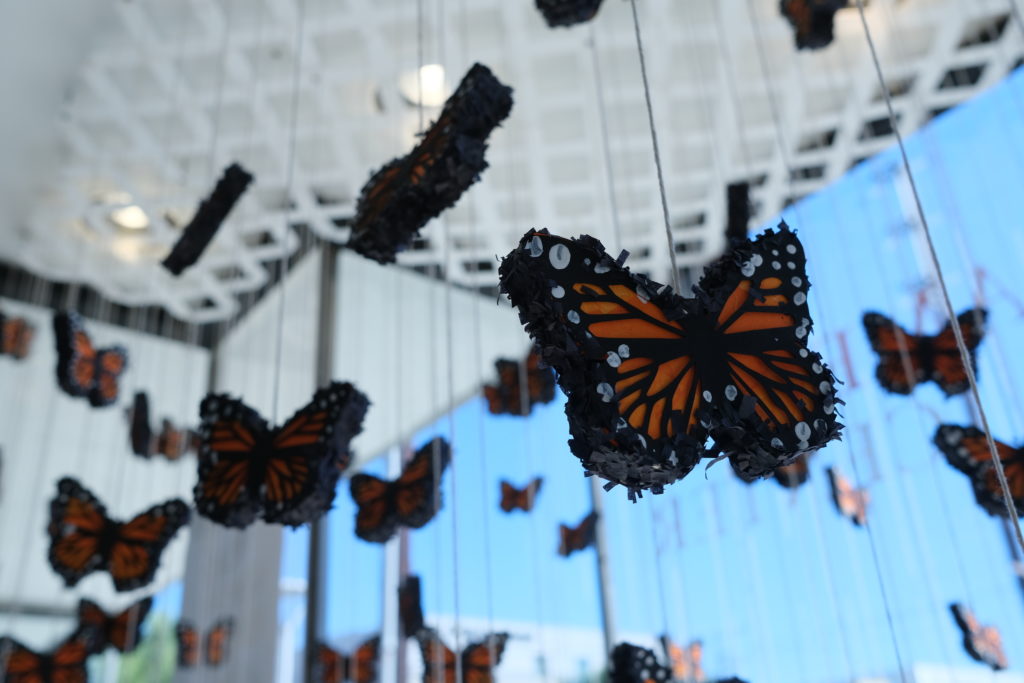
"I want to invoke a bit of emotion," said Rodriguez, who makes 1 ½-inch burro, unicorn, and vegan taco piñata earrings. Like Maya Angelou said — it's not what you say or do, it's how you make people feel.
He and Favela were featured in NHCC's "The Piñata Exhibit (Sure to be a Smash Hit!)," which included a 1930s vintage clay piñata of a Mexican woman dressed in traditional china poblana attire. The relic, made using clay pottery, Spanish-language newspaper clippings, tissue paper, papier mâché and foil, was the inspiration for the New Mexico exhibit.
The piñata we know today, in all its whimsical fringed glory, is from Mexico. However, the roots of breaking something and getting a surprise inside are said to date back to China more than 700 years ago. Figures of cows, oxen and buffalo were covered in colorful paper that, when broken with a stick, spilled out seeds on the ground. Those seeds were then burned, their ashes stored for good luck. The custom spread to Italy, where clay pots were used during Lent. In Spain, decorated ollas (pots) were used by Spanish missionaries to attract potential converts. The Indigenous people, in what is now considered Mexico, already had a similar tradition. To celebrate the birthday of Huitzilopochtli, the Aztec god of sun and war, priests placed a clay pot adorned with colorful feathers on a pole in their temple. When broken, treasures fell to the feet of the god's image as an offering. The Mayans played a game similar to our birthday tradition today, where the player's eyes were covered while hitting a clay pot suspended by string. Missionaries transformed these games for religious purposes, creating a star shape with seven points that symbolized the seven deadly sins.
Favela is by far the most well-known piñata artist. His pink 1967 Chevy Impala lowrider piñata, a built-to-scale ranfla titled "Gypsy Rose Piñata," debuted at L.A.'s Petersen Automotive Museum in a 2017 exhibit. The Las Vegas artist, who is half Guatemalan, half Mexican, presents a toned-down piñata piece on board titled "Baño de los Pescaditos," a homage to 19th-century Mexican painter José Maria Velasco who made Mexican geography a symbol of national identity. Favela covered an abandoned Vegas motel in hot pink tissue paper to symbolize people of color visibility in a town that doesn't seem to care for his 2016 "Piñata Motel" installation.

"As a queer person of color in the United States, I believe expressing joy, taking up space and simply existing is a political act," Favela wrote on his website.
Prieto echoes similar sentiments. The third-generation piñata maker from South Central L.A. opened Pinata Design Studio in 2017. The custom-piñata space grew out of being raised in a place called Piñata House, where her grandma, tía and cousins sold piñatas illegally by day and hosted punk shows at night. Eventually, the underground piñata shop was shut down for not having a permit to sell. A childhood spent drawing eyes and pasting them onto piñatas led to her expanding on the craft with a college degree in business and knowledge of trade. With a list of clients that include Google, Rihanna and Nike, her piece "All That Glitters" features a mobile-like hula hoop with three metallic diamonds and fringe that hang like a disco ball. Its title represents an art form she considers slave labor.

"People have this idea that the piñata is cheap and doesn't take a lot of work," the 31-year-old artist said. "Capitalism has put a hindrance on us because we're always competing with Wal-Mart, Target and Party City. We're a dying art form."
Her piece, "In God We Trust," which was also displayed in the window, is a huge papier mâché hand with a tiny piñata held between the thumb and pointer finger. A repurposed clock and chain bind it, signifying both the American and undocumented immigrant experience making party piñatas for little pay and no recognition.
Giovanni Valderas is another political piñata artist on the lineup. The Texas-based artist plops his piñatas down in areas being developed and gentrified as a cry for cultural preservation.
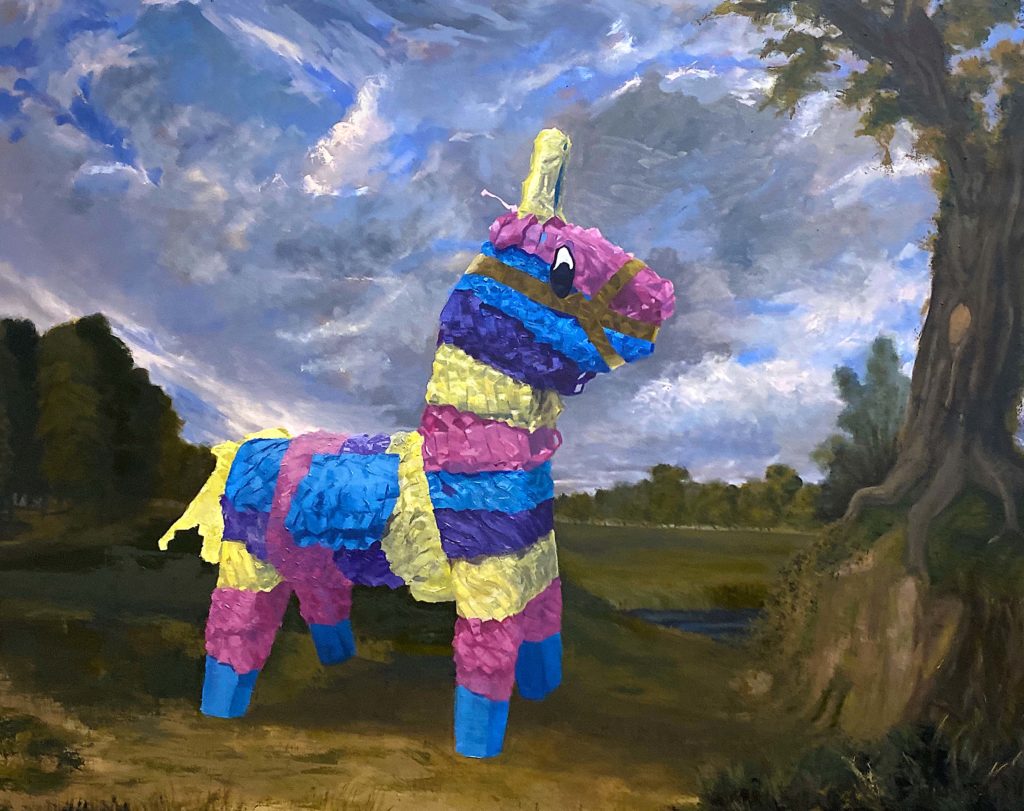
A traditional burro piñata hangs from the ceiling at the center of the gallery. Purchased in the Piñata District, the store owner would only give the artist's first name: Judith. Dignicraft wants to change that narrative. The Tijuana-based artist collective highlights the Indigenous Purépecha artisans who make piñatas but are invisible to consumers through a series of videos, photos and workshops. In "High Art of Celebration," piñatas of a cheramati (fisherman on canoe) with a net in tow and nanachi (woman) with braids holding a platter that says "Janitizio," a fishing town in Michoacan only accessible by boat, are displayed.
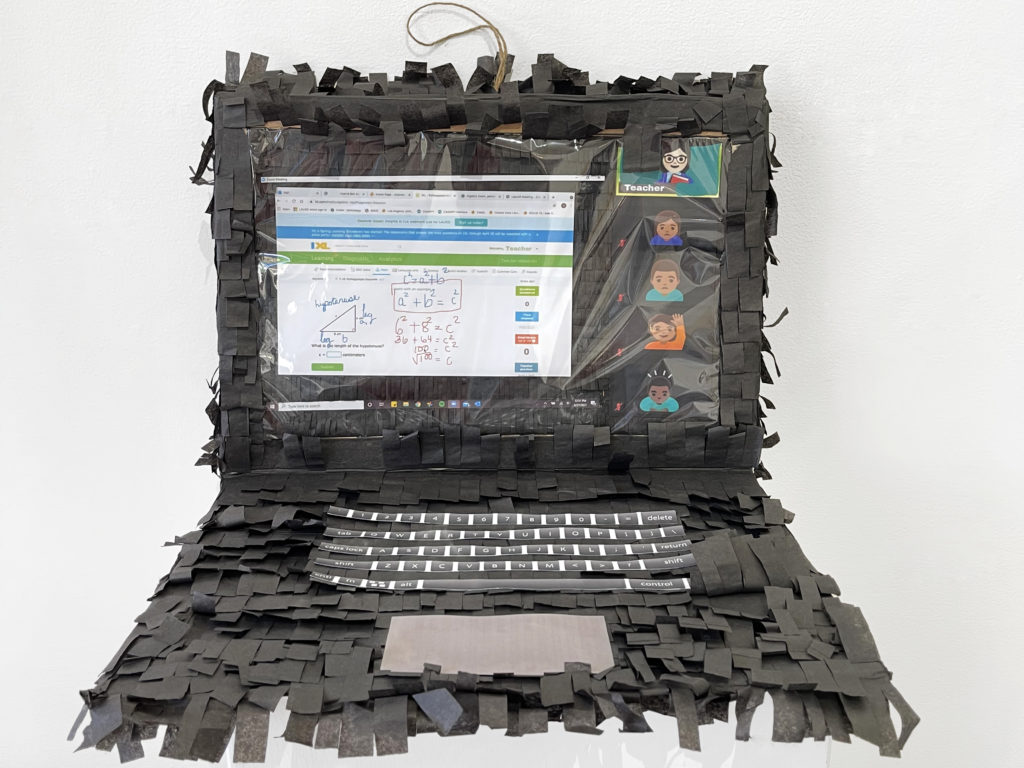
Amorette Crespo knows the hustle well. The 35-year-old L.A.-based artist, who started the Etsy shop Party Girl Piñatas, worked for nonprofits like The Skirball and Levitt Pavillion before becoming a real estate agent to make ends meet. She started making piñatas in 2017, when her daughter turned 10 and wanted a Selena-themed party. They went to the Piñata District and were quoted $50 for a microphone piñata (she didn't want to hit Selena) that would take a week to make. She ended up making a two-foot microphone stained at the top to look like Selena's lipstick marks with cardboard and tissue paper she had at home.
"When I was in elementary school, we couldn't afford theme parks or vacations," Crespo said. "I would go to the library and check out arts and crafts books and use things we had around the house to entertain myself."
Her Selena and Hot Cheetos piñatas resonate with the Latinx people almost as much as her Zoom school-themed piñatas do with parents who had to endure frustrating remote learning with their kids during the height of the pandemic.
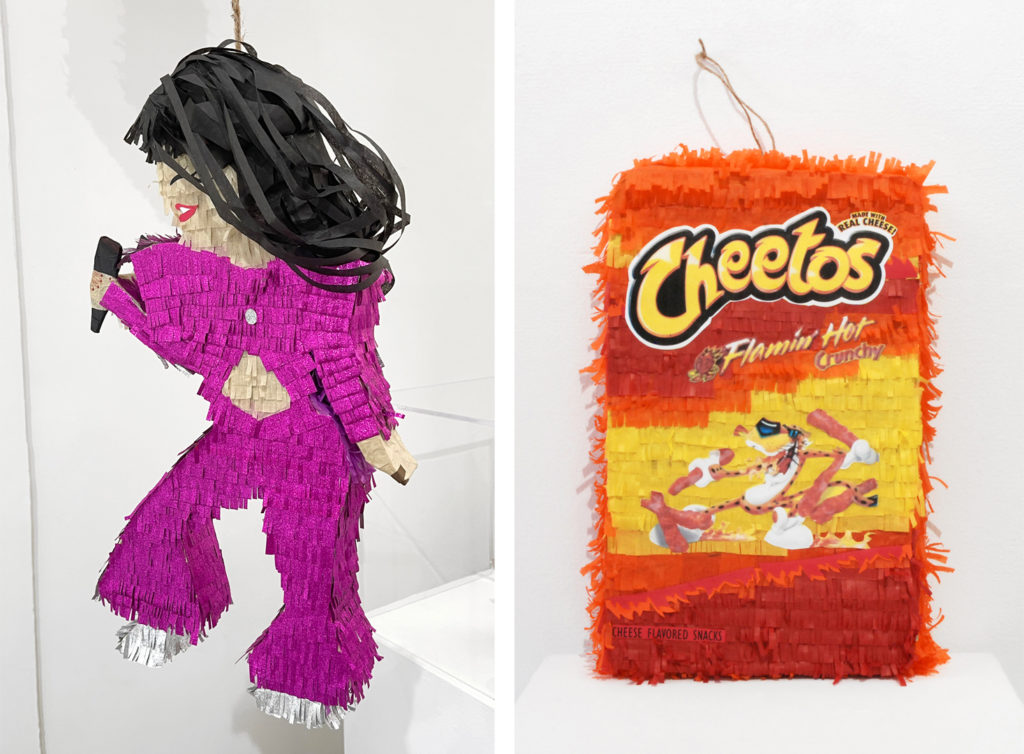
I sat down with Roberto Benavidez at his home studio in El Sereno, located on the eastside of L.A. The South Texan queer artist, whose father is Mexican and mother is white, wore a three-quarter sleeve baseball T-shirt with "Vota" printed on the front and shorts. Several piñata pieces hung from the ceiling and stood on the floor. Lifelike crows, a miniature kangaroo and a 6-foot giraffe surrounded us like officemates while I dissected his craft.
Growing up in the small town of Beeville, Texas, about an hour from Corpus Christi, acting was the only accepted art form. He got a degree in it, but his heart belonged to sculpting. He started making little mushroom people out of polymer clay (a gateway material for many sculptors) before moving to L.A. in 2000. He took art classes at Pasadena City College at night while working a corporate job during the day. He stumbled upon a piñata online that someone made for their kid's birthday and the process intrigued him.
"I can do this," Roberto Benavidez thought. "I can refine a piñata and expand upon what the craft already is.'"

He started with a series of sugar skull piñatas, making florets by holding the center of square pieces of tissue paper and twirling them to create little flowers. It wasn't until he discovered "El Piñatero/The Piñata Maker," a 1994 book written in by the late Mexican American children's book author, photographer, and filmmaker George Ancona, that his style cemented. The book beautifully details, in Spanish and English, how a craftsman named Don Ricardo (or Tío Rico, as the children call him) from a small village in Mexico makes piñatas for all the local birthday parties and fiestas. Roberto Benavidez was inspired by Don Ricardo's use of crimping shears and started making serrated v-cuts to streamers rather than a traditional straight fringe. He switched to a crepe paper made in Italy and, in 2014, left his corporate job to pursue art full time. His "Illuminated Piñata" series features an assortment of hybrid animals (some with burro heads, some with burro bodies) and are the first thing you see when you walk inside the gallery.

Diana Benavidez's "Border Crosser" and "La Pinche Migra" remote control car piñatas reflect life growing up in Chula Vista, California, which straddles the Mexican border. Based in San Diego, the 32-year-old teaching artist calls herself a transborder individual, who grew up bouncing back and forth between two countries so close, yet so far. Piñatas were very much a part of her daily life.
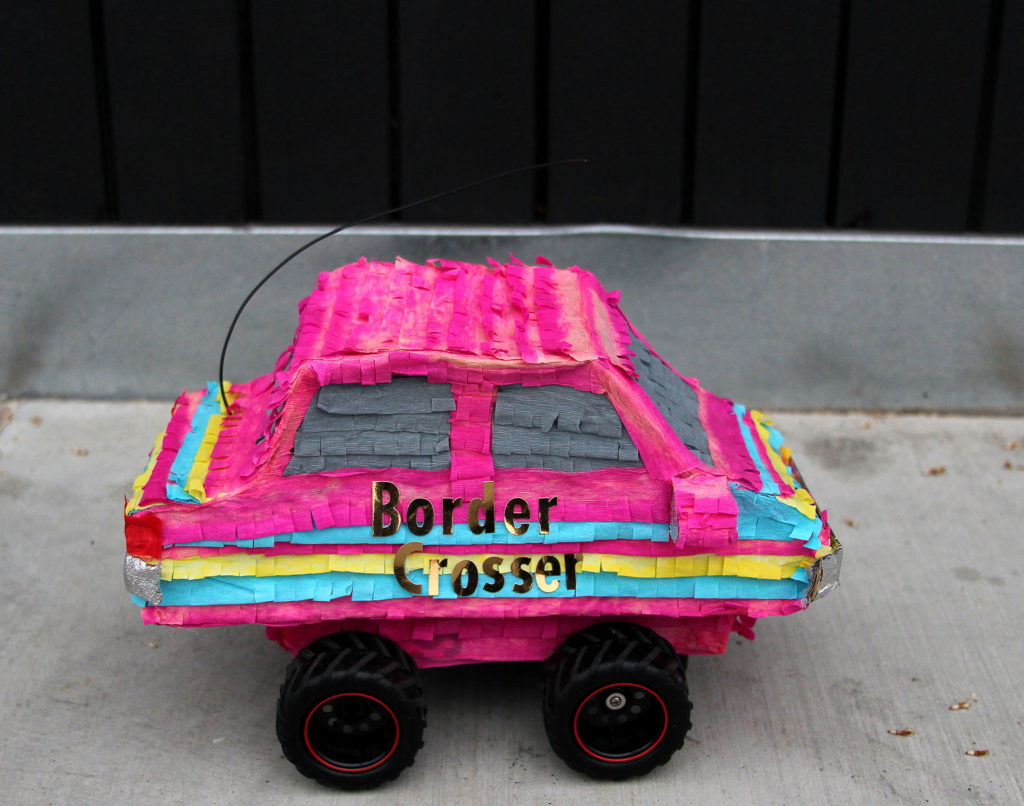
"While my family waited to cross the border from Tijuana to San Diego, our car was surrounded by trinkets and crafts for sale," said Diana Benavidez. "Hello Kitty piggy banks, mini glass-blown crucifixes and San Diego Charger blankets swayed from vendor's backs and makeshift stands."
These memories inspired her to adopt piñatas as an art form that represents her history and identity.
"My favorite cartoon characters were turned into tangible objects I refuse to break," she said.
This report originally appeared on KCET's "Artbound."
Support Canvas
Sustain our coverage of culture, arts and literature.


















